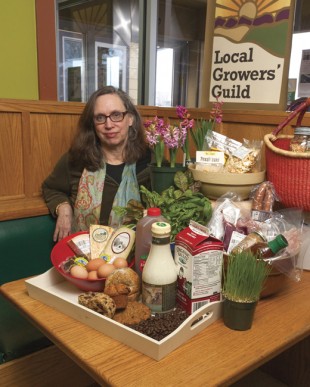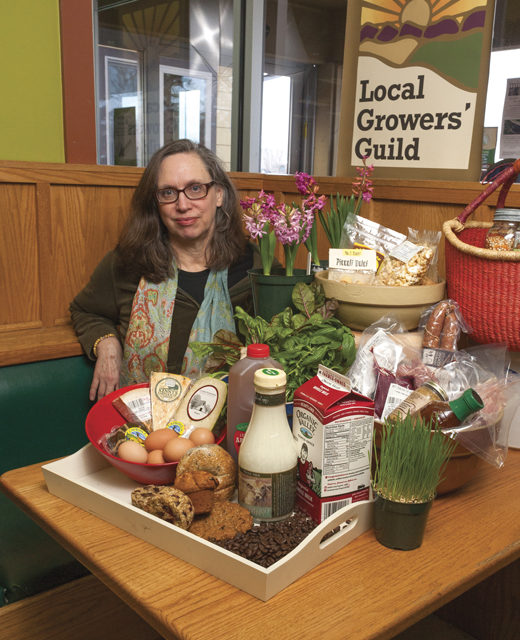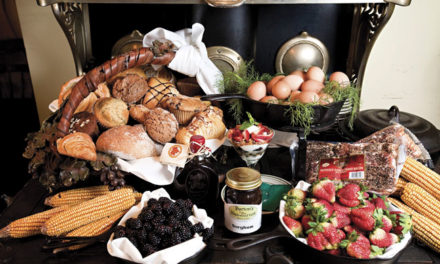
Ellen Michel with some of the local products carried at Bloomingfoods. Photos by James Kellar
BY CARMEN SIERING
Promoting local products may be trendy in the business sector right now, but for Bloomingfoods, supporting local producers is business as usual, says Ellen Michel, marketing and outreach manager for the cooperative grocery.
“We’ve had the same mission statement since 1976,” Michel says. “Even then, our founders were already thinking local.”
Walk through any of the three Bloomingfoods locations and you’ll find local products—from produce and meat to baked goods, soap, and flowers—in every aisle, with shelf markers noting the fact. At checkout, receipts record how much was spent on local meat, deli, grocery, bread, and wellness items. Produce is a little harder to track, but the store hopes to have those items represented in the future.
To strengthen its vision of supporting local, sustainable, organic, and fair trade goods, Bloomingfoods and six other co-ops founded the Principle Six (P6) initiative in 2010. There are now 11 co-ops in P6.
Michel says P6 is focused on building awareness of both local and global food chains and emphasizing the importance of supporting small farmers, artisan producers, and cooperative distribution.
“Without small, local, and co-op, we have less product diversity and economic justice, whether that’s in Indiana or Ireland or Costa Rica,” Michel says.
The commitment to P6 helps define “local” for Bloomingfoods, which, according to the store’s website, is “a product grown or produced in our region, or having value added in that region.” Michel says this means food made in the Bloomingfoods deli is considered local, as are coffee beans roasted locally but grown outside the United States. It also means there is no arbitrary mile limit on who might be considered a local grower.
“What’s local is dynamic,” Michel says. “We aren’t going to cut someone off because they farm 120 miles from Bloomington and we determined local is within 100 miles. What’s more meaningful to us is knowing the grower.”
One way Bloomingfoods gets to know local growers is by hosting informational meetings during the winter. The meetings are a way to meet farmers, answer their questions, and offer practical advice on everything from pricing and marketing to packaging and invoicing.
Megan Hutchison, manager of the Local Growers’ Guild, says having Bloomingfoods work with local farmers supports the efforts of her organization.
“A big part of what the Local Growers’ Guild does is education and advocacy,” Hutchison says. “I love that Bloomingfoods has the growers meetings and that they are promoting local foods in the store. They really work with farmers, and they are open to ideas, taking input if it’s offered to them.”
Michael Hicks, farmer and founder of Living Roots Ecovillage, is a self-described local-food advocate. He says he’s worked closely with Bloomingfoods to address the challenges and opportunities facing farmers who want to expand from direct sales, such as at farmers markets, to wholesale sales.
“I’ve been selling to Bloomingfoods since 2006,” Hicks says. “Our local farm scene has matured a lot over the past few years, and Bloomingfoods has stepped forward and created a structure that will significantly increase the amount of local produce in their food cooperative.”
Beyond produce, Bloomingfoods is working to add more local products to other departments. One of those areas is bulk foods.
Anna and Keith Welch farm 65 organic acres known as Fields of Agape. Their primary crops of golden flax, black beans, buckwheat, and popcorn are shipped in 25-pound bags and emptied directly into Bloomingfoods’ bulk bins.
“The less we have to package, the more sustainable we can become,” Anna says. “We can’t be successful at farmers markets, because we can’t afford to drive two hours and sell $60 worth of product. Bloomingfoods has supported our continued operations since 2009, and it probably makes up about 80 percent of our revenues.”
Welch credits the sophistication of Bloomington residents for the success they have had in selling to Bloomingfoods.
“The Bloomington market is so mature about food,” Welch says. “It’s a culture and a mindset where people never moved away from organic and whole foods, and where people know how to cook.”
While local might be a trend, it’s been part of Bloomingfoods’ mission for 37 years, Michel says. Now they just want to find ways to do more of it.
“We’re always looking at every department in our stores and trying to figure out how to make them more local,” Michel says.











